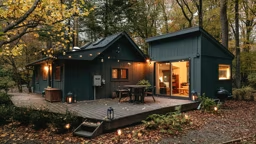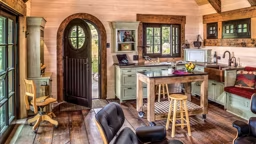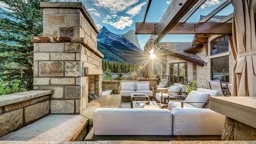Upgrading your deck? Take it to new heights with stylish railings and post caps.
Railings and posts don’t have to match the wood decking you walk on. A hot trend today is combining wood rails and posts with metals – or even glass. Adding a second material can set the average deck apart. (And you still have a ledge for your drink!)
While wood alternatives may cost more initially, they require little or no maintenance. Another plus for cabin owners: Many of the new railing options offer an almost unobstructed view of the great outdoors.
So think beyond the standard 2x2-inch wood picket. Treat the area between your deck posts (also known as the infill area) as a blank canvas. Just remember: The railing is the most visible part of your deck, so it should harmonize with your cabin’s architecture. Also, keep Mother Nature’s elements in mind when designing, as well as privacy and your cabin’s orientation to sun and shade.
Railing with Style
Choose one of these options as your artistic medium. Or mix and match – the sky’s the limit!
Railings and posts don’t have to match the wood decking you walk on. A hot trend today is combining wood rails and posts with metals – or even glass. Adding a second material can set the average deck apart. (And you still have a ledge for your drink!)
While wood alternatives may cost more initially, they require little or no maintenance. Another plus for cabin owners: Many of the new railing options offer an almost unobstructed view of the great outdoors.
So think beyond the standard 2x2-inch wood picket. Treat the area between your deck posts (also known as the infill area) as a blank canvas. Just remember: The railing is the most visible part of your deck, so it should harmonize with your cabin’s architecture. Also, keep Mother Nature’s elements in mind when designing, as well as privacy and your cabin’s orientation to sun and shade.
Railing with Style
Choose one of these options as your artistic medium. Or mix and match – the sky’s the limit!
1. Stainless steel cable, installed horizontally between posts, is durable and virtually invisible – ideal for that ocean or mountain vista.
Sources:
• AGS Clearview Cable Rail,
www.agsstainless.com
• Atlantis Rail Systems,
www.atlantisrail.com
• Feeney’s CableRail,
www.feeneyarchitectural.com
• Ultra-Tec Cable Rail,
www.wagnercablerailing.com
Sources:
• AGS Clearview Cable Rail,
www.agsstainless.com
• Atlantis Rail Systems,
www.atlantisrail.com
• Feeney’s CableRail,
www.feeneyarchitectural.com
• Ultra-Tec Cable Rail,
www.wagnercablerailing.com
2. Wrought-iron balusters contrast nicely with wood, and make a railing open and airy. Choose from contoured balusters or ones with a flat or a tubular profile.
Sources:
• House of Forgings Deckscape Outdoor Balusters, www.houseofforgings.net.
Sources:
• House of Forgings Deckscape Outdoor Balusters, www.houseofforgings.net.
3. Steel panels with nature-themed designs make your railing a work of art. Opt for different designs between posts, or make a single panel he focal point of a wrought-iron balustrade.
Sources:
• NatureRails, www.naturerails.com
• J. Dubs, www.jdubs.com
Sources:
• NatureRails, www.naturerails.com
• J. Dubs, www.jdubs.com
4. Tempered glass lets you see the lake from your deck chair. Shatter- and scratch-resistant glass balusters and solid panels are available in clear or tinted shades.
Sources:
• Clearview Railing System, www.railsimple.com
• Deckorators’ Scenic glass balusters, www.ufpi.com.
Sources:
• Clearview Railing System, www.railsimple.com
• Deckorators’ Scenic glass balusters, www.ufpi.com.
5. Aluminum balusters come in wavy or curved shapes - a fun accent for a contemporary cabin.
Sources:
• Deckorators’ Architectural Series,www.ufpi.com.
Sources:
• Deckorators’ Architectural Series,www.ufpi.com.
Cap It All Off
Instead of a continuous top rail, consider extending some or all of the posts above it to create interest. Then dazzle the deck with railing post caps and/or lighting.
Post caps are not only decorative, they’re functional, too. They help preserve wood posts by keeping water from wicking down into the end grain. Post caps can also house solar or low-voltage outdoor lights to guide guests at night. Caps come in various wood ball and finial shapes that can be painted, as well as metal and glass.
6. Copper post caps are available in round, square and rectangular shapes. The copper will oxidize to a rustic, antique finish over time.
Sources:
• Nortek Copper Works, www.nortekcopperworks.com
• Rail Simple Decorative Post Caps, www.railsimple.com
Instead of a continuous top rail, consider extending some or all of the posts above it to create interest. Then dazzle the deck with railing post caps and/or lighting.
Post caps are not only decorative, they’re functional, too. They help preserve wood posts by keeping water from wicking down into the end grain. Post caps can also house solar or low-voltage outdoor lights to guide guests at night. Caps come in various wood ball and finial shapes that can be painted, as well as metal and glass.
6. Copper post caps are available in round, square and rectangular shapes. The copper will oxidize to a rustic, antique finish over time.
Sources:
• Nortek Copper Works, www.nortekcopperworks.com
• Rail Simple Decorative Post Caps, www.railsimple.com
7. Glass caps are available in jewel tones like garnet and sapphire, as well as Tiffany-style designs with or without solar lighting.
Sources:
• Universal Forest Products’ Maine Ornamental Series, www.ufpi.com.
Sources:
• Universal Forest Products’ Maine Ornamental Series, www.ufpi.com.
8. 12-volt lights can be installed as post caps, mounted on a post, or under the top rail.
Sources:
• Kichler Lighting, www.kichler.com.
Sources:
• Kichler Lighting, www.kichler.com.
Up to Code
Building codes can vary widely from municipality to municipality. But the following guidelines often apply:
• Railings are typically required on any deck over 30 inches above the ground or above a lower deck platform.
• Vertical balusters usually must be no more than 4 inches apart; bottom rails can have no more than 4 inches of open space below them.
• Posts typically should be no more than 6 feet apart.
• Most codes require railings to be at least three feet above the decking.
• Again, remember to check with your local building inspector for codes in your area before starting your project.
New York writer and frequent contributor Fran Sigurdsson enjoys summer evenings from her little deck in the Adirondacks.
Building codes can vary widely from municipality to municipality. But the following guidelines often apply:
• Railings are typically required on any deck over 30 inches above the ground or above a lower deck platform.
• Vertical balusters usually must be no more than 4 inches apart; bottom rails can have no more than 4 inches of open space below them.
• Posts typically should be no more than 6 feet apart.
• Most codes require railings to be at least three feet above the decking.
• Again, remember to check with your local building inspector for codes in your area before starting your project.
New York writer and frequent contributor Fran Sigurdsson enjoys summer evenings from her little deck in the Adirondacks.


















